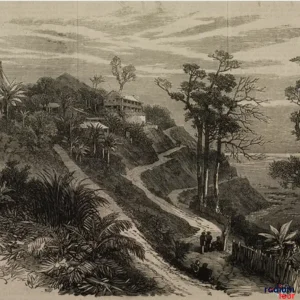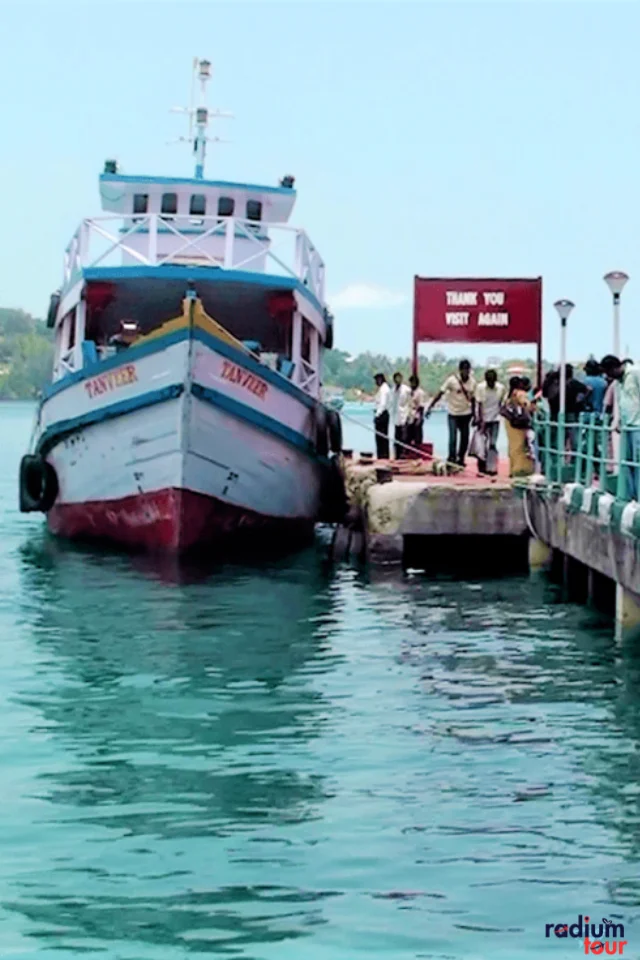Reaching Ross Island: A Quick Guide
Ross Island, officially recognized as Netaji Subhash Chandra Bose Island, is a captivating destination nestled within the enchanting Andaman Islands archipelago. This island gem is an integral part of the South Andaman administrative district, located a mere 3 kilometers east of the bustling heart of Port Blair, the capital of the Andaman and Nicobar Islands.
Stepping onto Ross Island is like embarking on a journey back in time. The island proudly displays its historical remains, which act as eloquent testimony to a bygone period. It’s understandable why this piece of heaven has gained popularity as a must-see tourist destination.
The transition of Ross Island from a thriving British colonial settlement to what it is now, Netaji Subhash Chandra Bose Island, is evidence of its rich and varied past. Ross Island functioned as the Andaman and Nicobar Islands’ administrative center when they were under British colonial rule. It was a hub of activity, with gorgeous gardens, grand colonial structures, and a thriving social scene.
Recent conservation and restoration sweats have saved and restored the island’s major structures, enabling current and unborn generations to marvel at this living gallery. Whether you are a history buff, a nature nut, or just seeking out a unique and affecting experience, Ross Island, also known as Netaji Subhash Chandra Bose Island, is sure to leave a continuing effect on your heart and mind. In the Andaman and Nicobar island, it’s a must- visit place because it honors the fiber of an area that has endured literal ups and campo.
Visitors to Ross Island are greeted by the echoes of history as they explore these historic ruins. The island’s rich vegetation serves as a magnificent setting for the surviving examples of British construction, which include a church, a bakery, and the home of the chief commissioner. These ruinous areas are like wandering inside a time capsule because each building holds a unique history and set of secrets.
Ross Island is a haven for nature enthusiasts as well as a historical treasure trove. Peacocks, deer, and various birds are among the tropical flora and animals that contribute to its allure. You can lose yourself in the island’s tranquil atmosphere as you explore it and make connections with the natural beauty that is all around you.
History of Ross Island in Chronicles
Ross Island, which has been renamed Netaji Subhas Chandra Bose Island, is an intriguing piece of history nestled in the Andaman and Nicobar archipelago. It owes its name to the British marine surveyor Daniel Ross and served as the headquarters of the Indian Penal Settlement for nearly a century.
This island, once known as the “Paris of the East,” boasted modern amenities that were astonishing for its time. From bustling bazaars and bakeries to a stately church, tennis courts, ballrooms, and even a printing press, Ross Island was a thriving hub of colonial life. It was a place where British officers and their families sought comfort and recreation in the midst of their challenging roles.
However, the island’s vibrant era took a sharp turn when a devastating earthquake struck in 1941. The aftermath left the island in ruins, leading to the abandonment of these once-grand structures. The very amenities that had made it the “Paris of the East” now lay forgotten and reclaimed by nature.

Ross Island’s historical significance goes beyond its British colonial past. During World War II, both British and Japanese forces left their mark on this small piece of land. The echoes of their presence can still be felt in the remnants that dot the island’s geography. One cannot explore Ross Island without encountering the stark reminders of its turbulent past. These ruins, crafted by Indian prisoners, serve as silent witnesses to the island’s history. They tell tales of suffering, resilience, and transformation, encapsulating the island’s journey through time. As you walk amidst these ruins, you’ll be transported to an era long gone but not forgotten. The architectural remnants, overgrown by lush greenery, are a poignant reminder of the island’s colorful history. They offer a glimpse into the lives of those who once inhabited and toiled on this remote outpost.
Ross Island still stands moment as evidence of a place’s capability to repel both natural disasters and literal runs. Callers are encouraged to consider the island’s history, which not only told the island’s present but also the history of the Andaman and Nicobar island as a whole. Ross Island is further than just a literal corner; it’s a place where history is indelibly inscribed into the gemstone and soil.

Reaching Ross Island: A Quick Guide
Ross Island, in close proximity to Port Blair, is just a short 15-minute boat ride away. The journey commences from the Aberdeen Jetty, conveniently located within the water sports complex.
To access the jetty, you can opt for a taxi or an auto-rickshaw, ensuring a hassle-free start to your adventure.
Notably, Ross Island is easily visible from Port Blair’s east coast, adding to its accessibility and allure.
Before embarking on your journey, remember to secure both a boat ticket and a Sound and Light show ticket, should you wish to attend. Ticket purchase procedures can vary, from online options to the IP&T counter or directly at the jetty. For the most up-to-date information, don’t hesitate to consult your hotel or travel agent. Your journey to Ross Island begins with preparation and ease.
Exploration Tips for Ross Island
Prepare for a 3-4 hour adventure on the island by wearing comfortable attire and sturdy shoes. Ross Island's charms unfold through leisurely walks and discoveries.
A stirring panoramic view of the girding islands awaits you at the top observation point, so make sure to climb there throughout your trip. You will not want to miss this chance.
As you cut the island, you may catch friendly deer and other wildlife. While it's tempting to interact, flash back not to feed them, as it's essential to maintain the island's ecological balance. Enjoy observing them from a regardful distance, and let the island's natural beauty allure you.
Significant Details about Ross Island
01.
The island earlier had social- period structures like a church, lyceums, tennis courts, stores, and a printing press that gave it the moniker” Paris of the East.”
02.
The island structures and services were abandoned after a ruinous earthquake in 1941, leaving them in ruins.
03.
During World War II, Ross Island witnessed the presence of both British and Japanese forces, leaving traces of their occupation on the island.
04.
Numerous of the structures and remains on the island were erected during the social period by Indian cons, displaying the continuing heritage of those who suffered imprisonment
05.
Moment, Ross Island is famed for its lush foliage, graphic views, and a variety of foliage and wildlife in addition to its literal significance.
06.
Callers now go to Ross Island to explore the literal cadaver, creatures, and enjoy the island’s lovely journeys.
07.
The literal stays on the island have been saved and kept in good condition so that excursionists can travel back in time and learn about its interesting history.
08.
After India attained independence, the island was given a new name in honor of Netaji Subhas Chandra Bose, a well- known Indian emancipation legionnaire.
- FOR INSURANCE
(007) 567-8976
Visitor Information for Ross Island
- Admission Fee: Adults (above 9 years): Rs 50 Children: Rs 25
- Ticket Counter Timings (Port Blair):Open from 9:00 AM to 3:00 PM
- Ferry Schedule:The first ferry departs at 8:30 AM.
- Light and Sound Show: begins at 5:30 PM. Three days’ notification in advance is required to purchase tickets. At the time of ticket purchase, proof of identity with a photo is necessary.
- Accommodation: On the island, there is no accommodation, thus staying overnight is not possible. Plan your visit accordingly, ensuring you have ample time to explore Ross Island and enjoy the captivating light and sound show.
FAQs
Ques. Are there any hidden caves or underground structures on Ross Island?
Ans. No, Ross Island doesn’t have hidden caves or underground structures. The majority of it is made up of open regions for exploration and surface-level colonial ruins.
Ques. Can you go scuba diving or snorkeling around Ross Island?
Ans. Ross Island isn’t an ordinary place to go snorkeling or scuba diving. Visitors come primarily to explore its historical ruins and natural beauty, but underwater activities are usually enjoyed at nearby locations like North Bay and Jolly Buoy.
Ques. Is there a unique flora or fauna specific to Ross Island?
Ans. Ross Island is famous for its natural beauty, yet neither its flora nor fauna are home to any rare or indigenous species. However, you can run into deer and other animals that the British brought to the island.
Ques. Are there any paranormal or supernatural stories associated with Ross Island?
Ans. There are no documented paranormal or supernatural stories specifically associated with Ross Island. Its history is more rooted in colonial times and the struggle for independence.
Ques. Can you camp or have a picnic on Ross Island?
Ans. Camping and picnicking are generally not permitted on Ross Island. It’s primarily a historical and ecological site, and activities are limited to exploring its ruins, scenic views, and wildlife observation.
